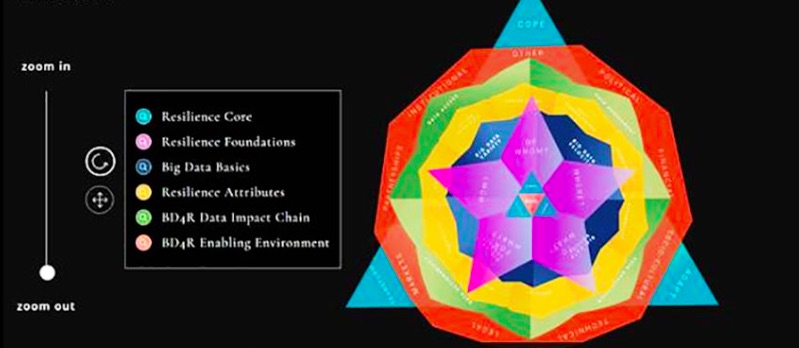
Most aspects of our lives are being reshaped by the unprecedented growth of global interconnections, including social networks. Huge quantities of digital data are produced and shared every day, at all times, by everybody. Data is increasingly generated and reported in real and near-real time, produced passively through digital services, and collected by an array of physical sensors—from weather sensors to traffic cameras, satellites and GPS.
We document our life experiences, communicate and learn from the world around us in ways that were unthinkable even just a few years ago.
What are the implications of this technological, informational and behavioral revolution for the way in which we pursue the Sustainable Development Goals and build resilience?
The emergence of very large datasets—characterized by their volume, velocity and variety: the three ‘V’s of Big Data[i]—is becoming particularly relevant for understanding the complex nature of vulnerability, as well as for improving the ability of systems—for example, households, communities or even ecosystems—to absorb, adapt, and potentially transform in the face of shocks and stressors—what we understand as building “resilience.”
A recent publication by the International Institute for Sustainable Development (IISD) examines the emergent role of Big Data as part of resilience-building processes through the experiences of seven international organizations: the UN Global Pulse, Conservation International, the Netherlands Red Cross, CGIAR, Mercy Corps, the Humanitarian OpenStreetMap Team, and IISD’s Experimental Lakes Area. The BD4R Storybook features the following cases:
A Novel Take on Resilience Building: Big Data’s role in freshwater ecosystems (International Institute for Sustainable Development (IISD) Experimental Lakes Area (ELA)
Enhancing Resilience to Peatland Fire and Haze Hazards: Haze Gazer (United Nations Global Pulse – Pulse Lab Jakarta)
Strengthening Urban Resilience Through Community-based Mapping: Dar Ramani Huria (World Bank funded by the UK Department for International Development (DFID) in partnership with Humanitarian OpenStreetMap Team, Tanzania Red Cross, Ardhi University, and the City of Dar es Salaam)
Informing Resilience Pathways: The Resilience Atlas (Conservation International)
Combining Small and Big Data to Enhance Resilience in Malawi (Netherlands Red Cross 510 data initiative and EU European Commission Humanitarian Organization)
Repurposing Mobile Technology to Build Resilience: Mongolia’s Advanced Weather Information System (AWI) (Mercy Corps)
Unlocking Big Data’s Potential to Strengthen Farmers’ Resilience: The Platform for Big Data in Agriculture (CGIAR Research Program on Climate Change, Agriculture and Food Security (CCAFS)
VAMPIRE: An integrated perspective to inform resilience decision making (Pulse Lab Jakarta)
This publication presents stories from around the globe about resilience-building efforts in rural Malawi, Mongolia and Indonesia, urban resilience in Tanzania, and freshwater ecosystems resilience in Canada, among other regional cases. The wide range of experiences presented in the Storybook provides new insights about an increasingly relevant field of inquiry. These experiences reflect not only the complexity of humanitarian and development contexts, but also the opportunities and challenges of using Big Data to build resilience.
The cases featured in the Storybook were analyzed using a new analytical model called the Big Data for Resilience kaleidoscope (BD4R-k) designed to help understand the role of Big Data in resilience building processes. The model helps to visualize the links between Big Data and resilience, to assess areas of strength and weakness, and to identify gaps and opportunities to strengthen resilience programming.
The analysis of these cases provided important insights for resilience practitioners, researchers and decision makers. Among them, three key lessons are:
The need to consider the whole ‘data impact chain’ by ensuring that Big Data is not only available, but also accessible, assessed, and effectively used by vulnerable communities and decision makers to prepare for and respond and adapt to the impacts of climate change, natural disasters, food insecurity, economic crisis, among other shocks and stressors.
The importance of using Big Data to foster cross-scale linkages, by enabling information and knowledge access and use among different stakeholders and across scales (e.g., local, regional, national and global levels) so we can respond more effectively, transparently and inclusively to the impacts of shocks and stressors.
The urgency of bridging the technological realm of the Big Data revolution with the practical implications of its use, particularly in resource-scare contexts. This involves identifying innovative approaches for contexts in which technology access and technical capacity remain scarce, as well as understanding and addressing context-specific challenges and limitations of Big Data.
High quality data that is accessible, reliable, and locally appropriate is increasingly necessary to address the challenges of the 21st century. But the true potential Big Data brings for sustainable development pathways is not about volume or powerful technology tools. Is about the change that information and knowledge can enable in people’s lives, by strengthening their resilience to ongoing and future shocks and stressors. It is about its role informing decision-making processes and turning information into action.
For policy and decision-makers, researchers and development practitioners, the key challenge ahead consists in ensuring that development programs, research and policy strategies go hand in hand with the Big Data revolution.
Further research, dialogue and collaboration across sectors and disciplines is needed to understand, learn and benefit from the rapid growth of global interconnectedness, and most importantly, to ensure that Big Data translates into more robust and sustainable development pathways for vulnerable people.
